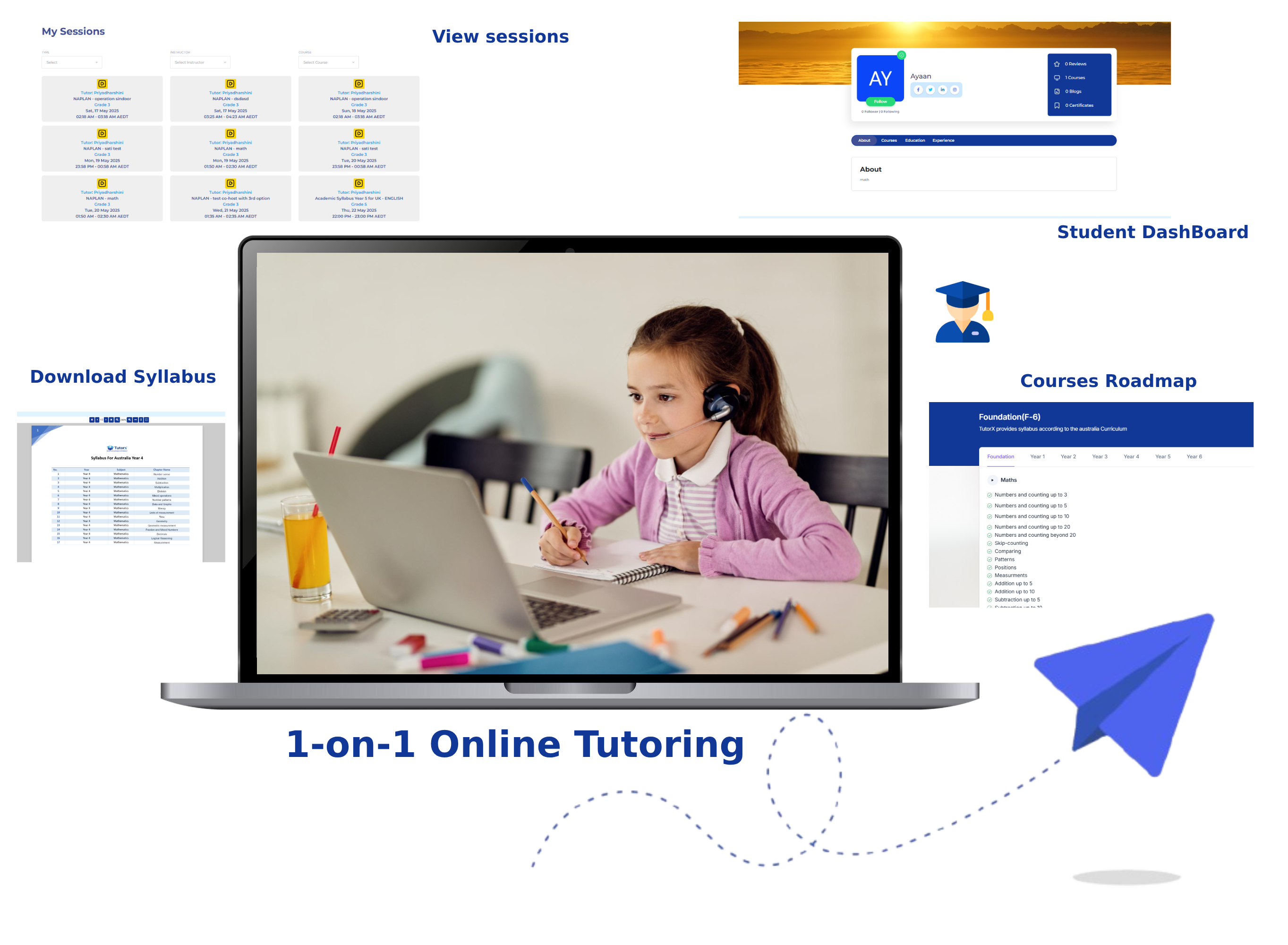Book a free trial session and start your personalized learning journey with our expert tutors.
Fill out the form below and one of our experts will contact you shortly.
Everything You Need, All in One Place
At The TutorX, we believe learning should be clear, focused, and at your fingertips. That’s why we’ve built a smart and user-friendly dashboard to empower every student on their academic journey. From live sessions and homework to performance tracking and resources—everything is seamlessly integrated to help you stay ahead with confidence.

The 13+ exam is a selection tool used by many independent and public schools to assess candidates for Year 9 entry. Typically, students sit papers in Mathematics, English, and Science. Additional papers may include Verbal and Non-Verbal Reasoning, languages, and humanities subjects.

The 13+ exam, also known as the Common Entrance Examination, is a selective test taken by students in Year 8 as part of the admissions process for independent senior schools. Most students who take this exam do so in the Spring or Summer terms of Year 8, with entry into their chosen school beginning in Year 9. While some mock or practice versions may be offered in the Autumn term, the main assessment usually happens later in the academic year. The structure and content of the 13+ exam can vary depending on the school, as many independent (public) schools tailor the papers to match their specific entry requirements. The exams typically last between 40 to 90 minutes and focus on key academic subjects such as English, Mathematics, and Science. In addition, some schools may include tests in Verbal Reasoning and Non-Verbal Reasoning, similar to those found in the 11+ exam. To further evaluate a student’s breadth of knowledge, schools might also assess subjects like History, Geography, and Languages (both modern and classical). The 13+ is designed to identify capable and well-prepared students who are ready for the academic demands of senior school. Preparation for the 13+ usually begins in Year 7 or early Year 8, giving students ample time to build confidence and strengthen subject knowledge. At The TutorX, our expert 13+ tutors are here to support you through the exam process and help you succeed in gaining admission to your preferred school.
There isn’t a fixed national pass mark for the 13+ Common Entrance Exam, as each independent school sets its own entry requirements. However, as a general guide, scoring around 60% or above is typically considered a pass, while 70% and higher is often seen as highly competitive for more selective schools. Some schools also allow for subject-specific strengths. This means a student might still be offered a place even if they score slightly lower in one subject, provided they perform strongly in others. For instance, a weaker result in English could be balanced by higher scores in Maths and Science, depending on the school’s overall expectations.
The number of questions in the 13+ exam depends on the exam board and the way each test is structured. For most students taking the GL Assessment version of the exam, there are typically two or three papers, and each one may cover a mix of different subjects. Common combinations include two papers—one testing English and Maths, and another testing Verbal Reasoning and Non-Verbal Reasoning. Alternatively, the test might combine English and Verbal Reasoning in one paper, and Maths and Non-Verbal Reasoning in another. In some cases, students might sit three separate papers—one each for English, Maths, and either Verbal or Non-Verbal Reasoning, or a blend of both. For full-length GL Assessment papers, the typical number of questions per subject is: English: 50 questions Maths: 50 questions Verbal Reasoning: 80 questions Non-Verbal Reasoning: 80 questions.
Each paper in the 13+ exam usually lasts between 45 to 60 minutes. This often includes a few minutes of unscored practice questions at the beginning, helping children get familiar with the format and reduce anxiety. In most cases, children take two or three papers on the same day, with a short break in between. However, some schools may choose to split the papers across different days, such as over two consecutive Saturdays.
The 13+ Common Entrance Exam is taken by students typically in Year 8, as part of the admissions process for independent secondary schools. The exam covers a broad range of subjects designed to assess both academic knowledge and critical thinking. Below is a summary of the core subjects usually included in the 13+ syllabus.
| Component | Description |
|---|---|
| Reading | Includes unseen literary prose and poetry passages. Students must interpret, evaluate, and analyze the text using literary techniques such as inference, comparison, and language analysis. |
| Writing | Students must produce structured responses such as persuasive, explanatory, or descriptive writing. Emphasis is on style, clarity, grammar, and original thinking. |
| Discipline | Key Topics |
|---|---|
| Biology | Cells, nutrition, digestion, respiration, reproduction, photosynthesis, genetics, variation, health, and ecosystems. |
| Chemistry | States of matter, elements and compounds, physical/chemical changes, acids, alkalis, and reactions. |
| Physics | Energy, motion, force, density, sound, light, electricity, magnetism, and an introduction to space science. |
| Topic Areas | Content |
|---|---|
| Number and Algebra | Four operations, fractions, decimals, percentages, ratios, sequences, expressions, equations. |
| Geometry | Angles, shapes, area, volume, transformations, coordinates. |
| Data and Measure | Graphs, charts, units of measure, averages, probability, real-life word problems. |
| Type | Focus |
|---|---|
| Verbal Reasoning | Tests understanding of word patterns, logic with letters and vocabulary-based problem solving. |
| Non-Verbal Reasoning | Assesses pattern recognition, shape manipulation, sequences, and spatial awareness using images and diagrams. |
Administrator

Lorem Ipsum is simply dummy text of the printing and typesetting industry. Lorem Ipsum has been the industry's standard dummy text ever since the 1500s, when an unknown printer took a galley of type and scrambled it to make a type specimen book.
Lorem Ipsum is simply dummy text of the printing and typesetting industry. Lorem Ipsum has been the industry's standard dummy text ever since the 1500s, when an unknown printer took a galley of type and scrambled it to make a type specimen book. It has survived not only five centuries, but also the leap into electronic typesetting, remaining essentially unchanged. It was popularised in the 1960s with the release of Letraset sheets containing Lorem Ipsum passages, and more recently with desktop publishing software like Aldus PageMaker including versions of Lorem Ipsum.
Reach out to TutorX your questions spark the path to smarter learning
